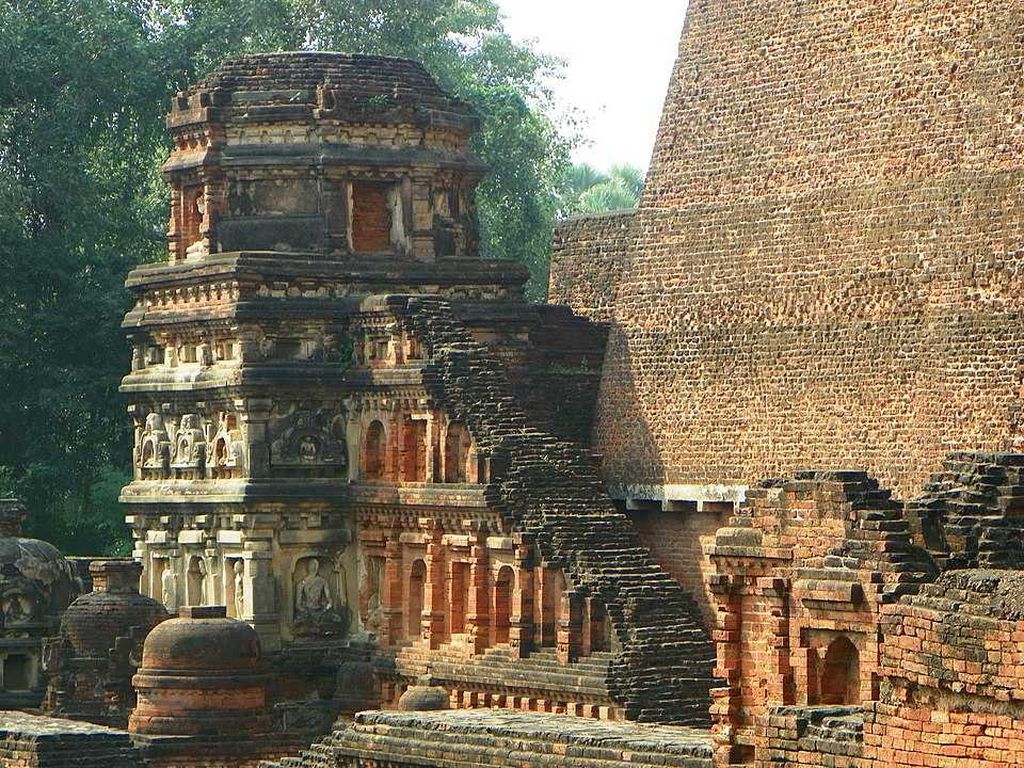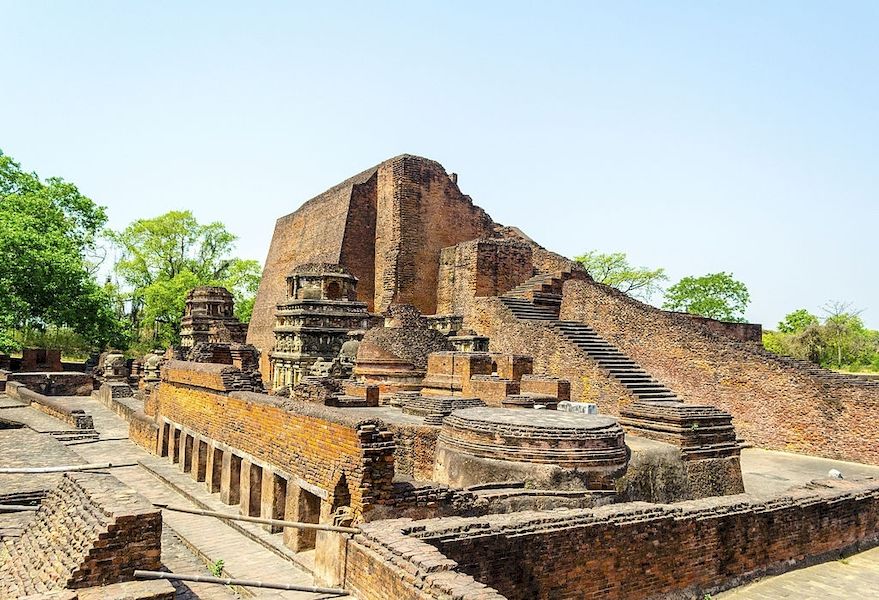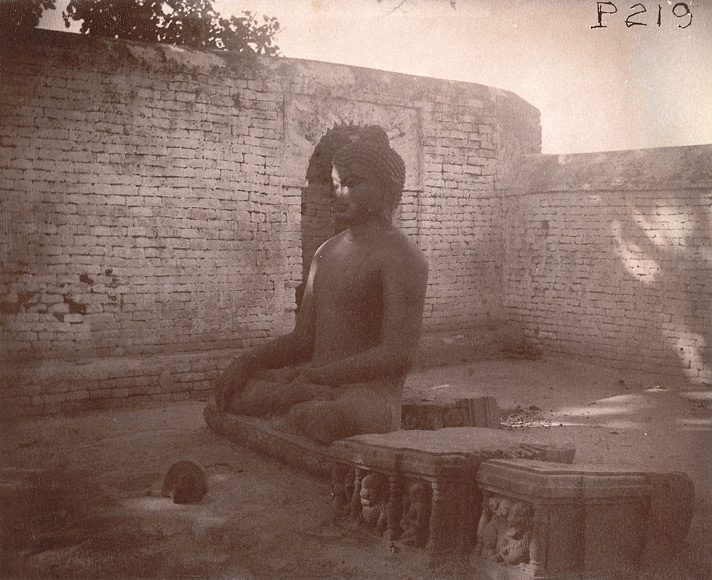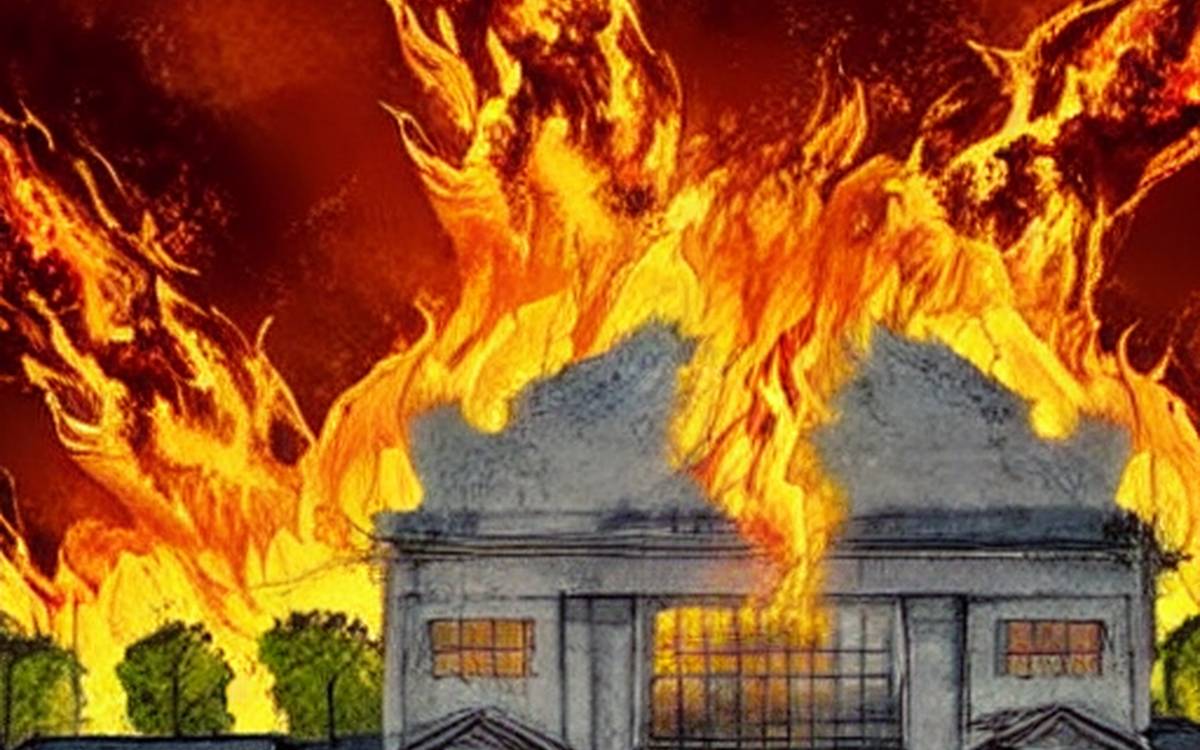It was a dark and stormy night in the year 1197 CE. The invading forces of the Muslim Turkic ruler Bakhtiyar Khilji had reached the gates of the ancient University of Nalanda. For over 600 years, Nalanda had been a beacon of learning and knowledge, drawing scholars from all over Asia to its doors. But now, it was about to be destroyed.
As the soldiers of Khilji broke down the gates and stormed the University, the scholars and students inside knew that their time was up. The University was a Buddhist institution, and Khilji saw it as a threat to his power. He ordered his soldiers to burn the University to the ground and destroy its vast collection of books and manuscripts.
The scholars and students fought back as best they could, but they were no match for the relentless soldiers. The University was soon engulfed in flames, and the invaluable manuscripts and texts that had been carefully preserved for centuries were reduced to ash.
As the sun ascended on the blazing ruins of Nalanda the next morning, it was clear that a great tragedy had occurred. The University had been a cornerstone of learning and knowledge in India, and its destruction was a devastating blow to the country’s cultural heritage.

Nalanda University was no ordinary building, it was an ancient center of learning in the Indian state of modern-day Bihar (ancient Magadha). It was founded in the 5th century AD, and quickly became a renowned institution of Buddhist learning.
It is considered by historians to be the world’s first residential university and one of the greatest centers of learning in the ancient world.
Located near the city of Rajagriha (now Rajgir) and about 90 kilometers southeast of Pataliputra (now Patna), the University operated from 427 until 1197 CE.
During this time, Nalanda played a crucial role in promoting the patronage of arts and academics, particularly during the 5th and 6th centuries CE, a period that has been referred to as the “Golden Age of India” by scholars.
The University’s impressive collection of books and manuscripts, as well as its reputation as a center of Buddhist learning, made it an important cultural and intellectual hub in ancient India.
The University was known for its vast collection of books and manuscripts and attracted scholars from all over Asia. It was visited by the Chinese monk Xuanzang, who wrote extensively about the University and its impressive collection of books and manuscripts.
The University of Nalanda was a major source of the 657 Sanskrit texts that were carried by the Chinese pilgrim Xuanzang to China in the 7th century.
These texts had a profound influence on East Asian Buddhism. In addition, the University was also the source of the 400 Sanskrit texts that were carried by Yijing to China during the same period. These texts continue to be studied and revered to this day.
The university had as many as 8,500 students and 1,500 teachers, which speaks volumes about the fame and popularity of the institution in ancient times.
Evidence for the burning of Nalanda University
The destruction of Nalanda is corroborated by three independent sources, which all corroborate the burning and related events but have uncertainties that raise some questions as well as a minor dispute about the exact date.

1. The writings of the Persian historian Minhaj-i-Siraj
The first mention of the destruction of Nalanda University can be found in the writings of the Persian historian Minhaj-i-Siraj. In his work Tabaqat-i Nasiri, Siraj describes a loot and massacre that occurred near Bihar Sharif. This account provides valuable insight into the events that led to the destruction of the University.
Muhammad-i-Bakht-yar, by the force of his intrepidity, threw himself into the postern of the gateway of the place, and they captured the fortress and acquired great booty. The greater number of the inhabitants of that place were Brahmans, and the whole of those Brahmans had their heads shaven, and they were all slain. There were a great number of books there–
and, when all these books came under the observation of the Musalmans — they summoned a number of Hindus that they might give them information respecting the import of those books– but the whole of the Hindus had been killed. On becoming acquainted [with the contents of those books], it was found that the whole of that fortress and city was a college, and in the Hindustani tongue, they call a college [مدرسه] Vihar.
This record of Minhaj-i-Siraj is not an eyewitness account, but it is an account of Samsamuddin who was with Muhammad-i Bakhtiyar Khalji, and Minhaj-i-Siraj merely summarizes it.
2. Tibetan records
The Tibetan records provide a second source of information about the destruction of Nalanda University in the late 12th and early 13th centuries. These records reveal that during this period, there was a widespread systematic destruction of monasteries in the region, including Nalanda.
Many monks from Nalanda and nearby monasteries such as Vikramashila were able to “survive the slaughter” by fleeing to Tibet, according to historian Hartmut Scharfe. These records provide valuable insight into the events that led to the destruction of the University.
Among the Tibetan records, the most useful is the biography of the Tibetan monk-pilgrim, Dharmasvamin discovered in 1936 and in bsdus-yig style, Tibetan script. It is useful because Dharmasvamin met the fleeing monks and famous scholars during his studies from about the mid-1200s to 1226.
He also learned Indian languages and Sanskrit, he walked to and stayed in Nepal starting in 1226 and visited Bihar in about 1234, including spending one monsoon season in Nalanda.
He described the situation in the decades after the sack of Nalanda and other Buddhist monasteries in the Magadha region of India.
His account states that the destruction of Nalanda was not an accident or misunderstanding but a part of the widespread destruction of Buddhist monasteries and monuments including the destruction of Bodhgaya.
[rb_related title=”You May Also Like” total=”4″ style=”dark” ids=”13409,7427,11550,1157″]
The vast manuscript libraries of Magadha had been mostly lost. Other Tibetan monks and he had shifted to Nepal, as the place to study, copy and move manuscripts to Tibet.
According to his account, the Turushka-Qarluq (Turk) conquest extended from about 1193 to 1205, the destruction was systematic with “Turushka soldiers razing a monastery to the ground and throwing the stones into Ganges river”, states Roerich.
The fear of persecution was strong in the 1230s, and his colleagues dissuaded him from going to Magadha.
According to George Roerich, “his (Chag lo-tsa-ba Chos-rje-dpal, Dharmasvamin) account conveys something of the anxiety of [the Buddhist community of] those days.
3. Discovery of a thick layer of ashes and charcoal
The third piece of evidence is the discovery of a thick layer of ashes and charcoal discovered during the archaeological excavations on the uppermost strata, inscribed artwork, and soil, and this layer was found over many buildings separated by some distance.
This suggests that Nalanda’s destruction was accompanied by a widespread fire after the mid-12th century
There are also some myths about the burning of Nalanda
Like many other historical events, there are also a lot of myths associated with the burning of Nalanda. The first one is about the number of books destroyed by fire, It is difficult to determine exactly how many books were in the collection of Nalanda University.
It is well known that the University was renowned for its large collection of Buddhist scriptures and texts, as well as books on subjects such as philosophy, mathematics, and astronomy.
The Chinese monk Xuanzang, who visited the University in the 7th century, wrote extensively about its impressive collection of books and manuscripts.
However, it is not clear exactly how many books were in the collection at the time of Xuanzang’s visit or at the time of the University’s destruction in the 1200s. This widespread myth about 9 million books being destroyed is purely speculative.

The second myth is about how long the university was burning. It is a widespread belief that the university was burning for three months. It is likely that the burning of the University took place over a period of several days, but there is no specific information on the duration of the event, or how many days it kept burning.
The third myth is about a story that says “Bakhtiyar Khilji had fallen sick and doctors in his court failed to cure him. Then, someone advised him to get himself cured by Rahul Sri Bhadra, the principal of Nalanda University.
Khilji was too proud of his Islamic culture and refused to get himself treated by a person outside his religion. But his health worsened and he was left with no other option but to invite Bhadra from Nalanda.
But Khilji put a condition and asked Bhadra to cure him without any medicines. Bhadra then asked Khilji to read some pages(medicine coated without the knowledge of Khilji) from the Koran as a remedy to his illness and to everyone’s surprise Khilji was cured.
Disturbed by the fact that an Indian scholar and teacher knew more than the doctors of his court, Khilji decided to destroy the roots of knowledge, Buddhism, and Ayurveda, from the country. He set fire to the great library of Nalanda and burned down nearly 9 million manuscripts.”
As mentioned earlier, there is simply no credible evidence to support the story and it seems like an exaggeration of a historical event.
Notwithstanding some of the myths, the destruction of Nalanda was a major loss to the cultural heritage of India. The University had been a center of learning for over 600 years, and its destruction marked the end of an era in Indian history. Many of the texts and manuscripts that were destroyed in the burning of Nalanda have never been recovered, and the loss is still felt to this day.
But the legacy of Nalanda lives on, even to this day. The memory of the University and its impressive collection of books and manuscripts continues to inspire scholars and researchers in India and around the world. The burning of Nalanda may have been a dark chapter in the history of ancient India, but its spirit lives on.
In 2010, the Government of India passed a resolution to revive the renowned University of Nalanda. As a result, a modern institution called Nalanda University was established at Rajgir. This new university has been listed as an “Institute of National Importance” by the Government of India.
The establishment of this new institution is seen as a way to honor the legacy of the ancient University of Nalanda, and to continue its tradition of promoting learning and knowledge.



